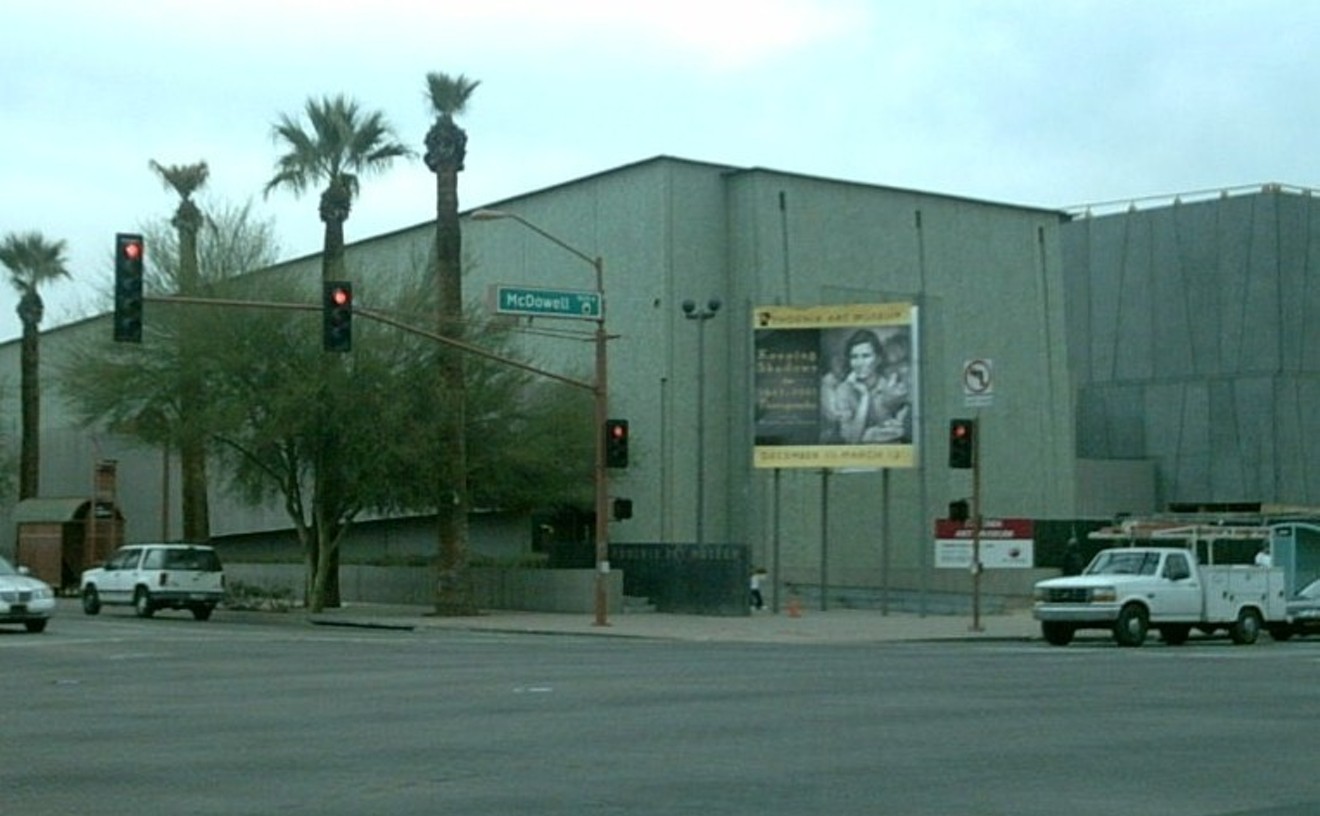Besides obnoxious, people who say that Phoenix has no culture are actually kinda racist. No culture? Tell that to the Heard Museum, the Southwest's premier hub of Native American art and history, home to educational events, art exhibitions, and festivals. It's been open since 1929, and serves as the Valley's go-to source for those curious about both their local history and what kinds of art indigenous people across the county craft. Wanna know the story behind the road named Indian School or the impact the region's railways had on its Native people? You'll find both — and get the chance to see contemporary artworks as well as historic items. And here you thought we were being dramatic.
Best Place to Learn About Native Southwestern Culture
Heard Museum
Best Trip to Outer Space
The Firefly Room at Phoenix Art Museum

Last time we checked, it cost about $20 million to take a jaunt on a commercial space flight, so until we've saved up the dough, we like to replicate an out-of-this-world experience at Phoenix Art Museum. "You Who Are Getting Obliterated in the Dancing Swarm of Fireflies," more commonly known as the Firefly Room, is a 2005 mixed-media installation with LED lights by Japanese artist Yayoi Kusama. Step inside (pro tip: move slowly, and keep your left hand on the wall until your eyes adjust), and you're transported to another realm; tiny color-shifting lights suspended from the ceiling get reflected in mirrored walls and a black marble floor to breathtaking effect, creating a dazzling, multi-hued starscape. We're still keeping an eye out for that NASA Groupon deal, but until then, the Firefly Room is your best bet for an in-town space odyssey.
- 1625 N. Central Ave., Phoenix, 85004 Map
- 602-257-1880
- www.phxart.org
Best Zen Experience
The Japanese Friendship Garden

Gridlock, haboobs, Sheriff Joe — life in Phoenix can be harsh sometimes. Fortunately, there exists in the center of town a space so secluded, so peaceful, we almost don't want a lot of people to know about it. Okay, fine. We'll share.
The next time you need a moment of Zen, you're welcome to join us at Ro Ho En, also known as the Japanese Friendship Garden of Phoenix. Completed in 2000 as a symbol of the relationship between Phoenix and its sister city Himeji, Japan, this 3.5-acre "strolling garden" offers stress relief and inner calm in the form of paved paths, shade trees, stone sculptures, friendly wildlife, and a central lake. The Garden hosts special events now and then such as tea ceremonies and an annual moon viewing festival, but really, any time is a good time to feed the koi, exhale deeply, and experience a little serenity now.
- 1125 N. Third Ave., Phoenix, 85004 Map
- 602-274-8700
- www.japanesefriendshipgarden.org
Best Play, Equity
Arizona Theatre CompanyOf Mice and Men
Arizona Theatre Company's production of John Steinbeck's Of Mice and Men this past spring was neatly rendered by an excellent creative team. Todd Edward Ivins' set design, moved to and fro by costumed, silhouetted ranch hands, provided expertly cheerless settings; Joe Cerqua's sound design and scoring and Jesse Klug's clever lighting design offered the only warmth in a series of deliberately dusty scenes of meager living. Director Mark Clements of Milwaukee Repertory Theatre, with whom this is a co-production, found the gentleness in Steinbeck's cruel tale of George and Lennie, a pair of drifters with naive dreams for the future. Scott Greer's magnetic rendering of Steinbeck's tragic, brain-damaged man-child Lennie was a stunner, and Jonathan Wainwright's George provided the quiet eye of Steinbeck's storm.
Best Play, Non-Equity
Stray Cat TheatreStupid Fucking Bird
It was easy to lose count of how many plays-within-a-play this seriocomic beauty comprised, thanks to a stage full of fine performances and some stunning commentary about what's wrong with theater and with the world. It was also easy to love Aaron Posner's play, which was "sort of adapted" from Anton Chekhov's famous 19th-century drama The Seagull.
A stunning cast burnished a lot of hammy, existential dilemmas and improv-busting devices, and director Ron May created some stunning stage imagery on Eric Beeck's slick and functional set.
Best Performance as a Talking Mirror
Terre Steed, Nearly Naked Theatre's Wonderland Wives
Buddy Thomas's raucous raspberry to childhood's best-known bedtime stories was neatly directed in its world premiere by Nearly Naked founder Damon Dering. If Valley of the Dolls author Jacqueline Susann had written fairy tales instead of potboilers, they might have resembled these second-act stories, whose heroines were all slatternly, marvelously grouchy, and mostly played by men. The effect was of an especially rambunctious Bette Davis impersonation contest, led by actor Terre Steed, who inched slightly ahead in this drag race if only because he portrayed four different women, most notably Snow White's Magic Mirror, an embittered, shrieking reflection of a baritone Baby Jane who convinces Snow not to be so pure. The real magic was in Mr. Steed's performance.
Best Local Boy Makes Good On Screen
Travis Mills
Jack Durant was a small-town gambler with loose ties to Vegas racketeers. He had a big, obstreperous personality, owned our city's most successful restaurant, and was listed among the FBI's most dangerous men in Phoenix. Jack liked women, eavesdropping on patrons of his restaurant bar, and golf. He might have seen one or two people being murdered. None of this makes for grand opera, but it did make for an independent feature film by local filmmaker Travis Mills. His stylish post-noir profile of one of Phoenix's bigger characters, Durant's Never Closes, increased Mills' profile as an indie filmmaker who shoots his low-budget, tightly shot movies right here in Phoenix. A new, young producer/director who can lure Hollywood A-listers like Tom Sizemore (who played the title role in the Durant picture) and director Peter Bogdanovich (who wanders through as a shady character trying to get Jack a spot in the local country club) is doing something right, and we're cheering him on.
Best Director
Damon Dering
If for no other reason than his comeback from a dreadful season opener, local theater bright spot and former wunderkind Damon Dering deserves accolades. Last fall, Nearly Naked Theatre founder Dering launched his new season with Monster, an adaptation of Mary Shelley's Frankenstein. Perhaps because Dering didn't helm the production himself, it stank. But this past master of camp knuckled down, leaping in to remind local theatergoers of his many visionary talents by directing a knockout world premiere of Buddy Thomas' Wonderland Wives, followed by an acclaimed production of Next to Normal that had critics and audiences swooning. These two winners more than made up for any transgressions, and reminded us that Dering is estimable in his talents — our very own Tyrone Guthrie.
Best Actress
Johanna Carlisle
She's nothing if not versatile. Mid-year, local star Johanna Carlisle delivered the best line of the play ("Just because I moved to Yorkshire doesn't mean I have to sit on it!" she bellowed when asked to take a seat on the ground) in Phoenix Theatre's Calendar Girls. As a British gal "of a certain age," she elevated a one-dimensional role with some subtle movement and more than a little wisecracking. A few months later, she stomped off with a well-polished production of Next to Normal at Nearly Naked Theatre, directed by company founder Damon Dering. As a suburban mom doing battle with bipolar disorder and trying to keep her family and life together, she sang and danced and emoted like crazy. Carlisle is a world of talent, all of it her own.
Best Actor
Beau Heckman
Terry Johnson's Hysteria requires a cast who can perform and respond to both broad slapstick and stagy melodrama, often in the same scene. Fortunately for theater audiences last fall, director Patrick Walsh assembled such a cast for the Southwest Shakespeare production of this peculiar masterpiece, which reimagines the meeting between psychologist Sigmund Freud and surrealist painter Salvador Dalí. Despite stiff competition from a gaggle of thespians, all of them running in and out of doorways and bellowing, Beau Heckman stood out as an especially fabulous Freud, both fearful of and besotted by his own knowledge of the emotional world.






